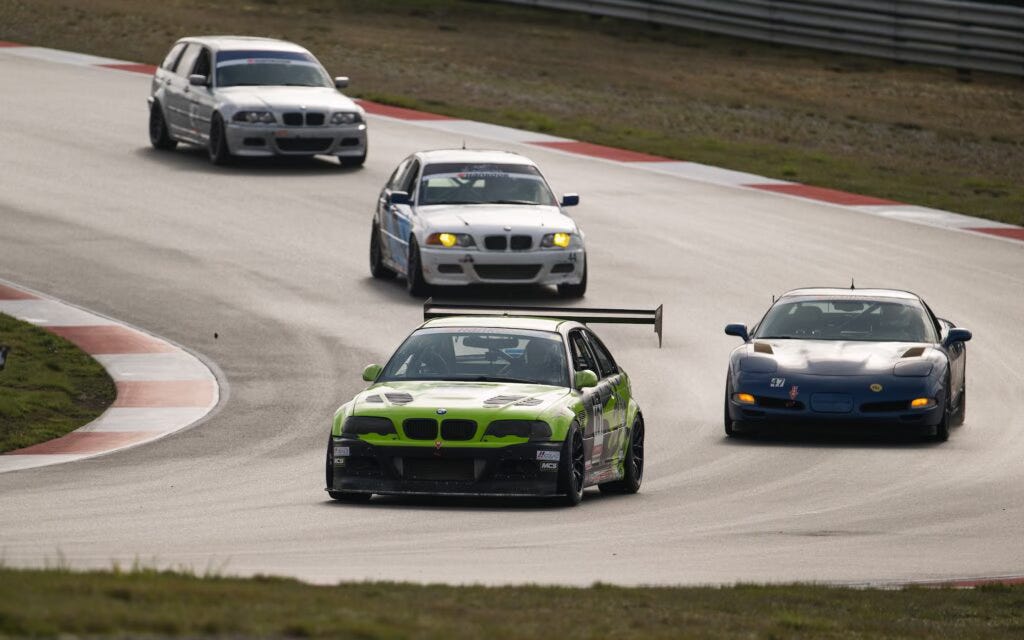Over the past year or so, I’ve raced in a few different “low budget” endurance race events. As far I’m concerned, racing in Lucky Dog, Champcar, AER, and WRL are really good series to practice one’s racecraft skills. With a mix of cars and driver skill levels, passing, being passed, and thinking strategically is critical.
On the flight home from one of these events, with what I’d observed and experienced fresh in my mind, I wrote the following:
What is racecraft? It’s the craft, skill, and technique of making passes in a clean, safe manner; it is also being passed in a clean, safe manner. In both cases, the goal is to lose as little lap time as possible, and to be respectful of your fellow drivers.
What is a clean, safe pass? One where there is no contact between cars, and any car is not put in a position where it could result in going off the track.
One of the most important aspects of racecraft, and especially in endurance racing, is knowing when to be patient, and when to be impatient. In fact, knowing when to be patient may be the most important. And…to know when to race, and when not to.
When a faster car is passing you, don’t race them. If they’ve caught up to you, there’s a reason: they’re faster than you. That may be because they’re in a faster class, they’re in a faster car, or at this point in the race, they’re just driving faster than you. Unless it’s the last lap or two, fighting them for position is probably going to cost you more than if you let them ease by you.
For example, if they’re making a pass in the brake zone, staying beside them hurts you more than helps you. They’re going to pass, so the sooner they do, the sooner you can get back to driving as fast as you can. To run alongside them in the brake zone, and especially in the corner, puts you in a worse position to get a good exit off that corner. It also hurts the passing car, and that’s okay if you’re racing it for position, but if it’s in a different class, or you are on different laps for some reason, fighting for position hurts both of you.
You need to know when to let other cars go. If they’re passing in the brake zone, let them get by you before the turn-in, then you can tuck in behind them on the ideal line and get a good exit (instead of trying to stay on their outside through the turn, hurting your exit). If you really want to defend your position, let them get into the corner slightly in front of you, and be ready to do the “over-under” and come out of the corner faster than they do on their inside exiting the corner.
In my experience from four races, this is the number one thing that drivers should focus on. Far too many times I would be passing a slower car, and the driver would try to run around the outside of me through a corner. The result? The slower car lost far more time than they should have (it had little to no effect on me).
Cars don’t just appear! If there is a car behind you and about to attempt a pass on you, you should have noticed them before that instant. And there’s a reason they’re about to pass you: they’re faster than you (again). Let them go, and learn from them.
Should you give up every pass? No, I’m not saying that. But you know when a car is faster than you are—at least, you should. If a car is barely faster than you, and it’s taking many laps for them to catch you, it’s okay to not just give up and wave them past you. But if they weren’t right on your rear bumper in the last brake zone, and now they are, they’re faster. Let them go.
The best race drivers know when to fight for position, and when not to. When you’re being passed, your goal is to lose as little time as possible. Running side-by-side through a corner, thinking that you’re proving a point about how fast you are in the corners, is hurting your lap times more than if you let them by. And no one cares if you’re faster through a corner than a faster car. Seriously, no one cares. What anyone cares about is how consistently fast your lap times are. That’s what wins races.
Speaking of consistency, that should be your priority. A single fast lap time is meaningless in a race, especially long endurance races. If you turn a lap that matches the track record, and then lose a couple of seconds or more every time you are passing or being passed, you’re not going to win. But if your fastest lap is a second off the track record, and your worst time in traffic is only a second off that, that will win races. That is impressive.
All the basic advice about racecraft applies doubly-so in endurance racing:


